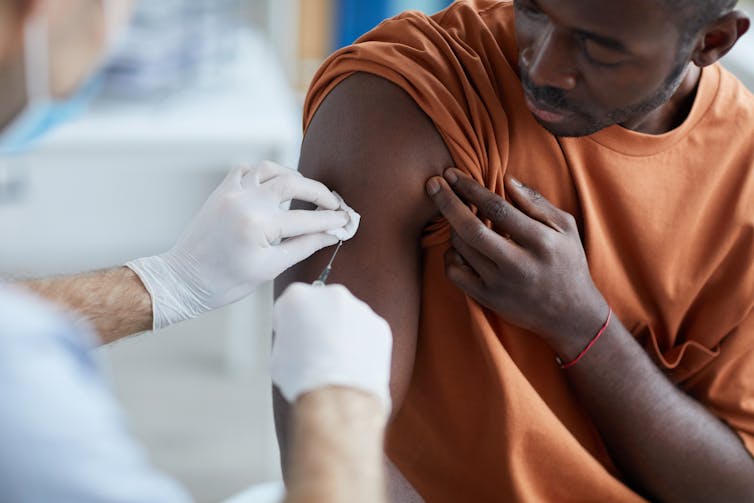
Since the beginning of July all there have been indications that COVID infections are increasing again in the UK.
The daily number of new positive tests and the proportion of tests coming back positive have been increasing since the end of June. New admissions to hospital with COVID and the number of beds occupied by COVID patients have also increased compared to levels seen at the end of June.
The latest official government data suggests that infections and hospitalisations are still rising. On the other hand, the Zoe App data (which is used to track COVID symptoms and infections) suggests that the current wave may have already peaked.
But with the Office for National Statistics no longer publishing COVID infection data, it’s not now possible to know with any degree of certainty just how many infections are actually happening in the UK each day – only how many tests have come back positive. But even with the July spike in infections and hospital admissions, hospital cases are still far lower than the levels we saw in previous summers – and even earlier this year.
There are a couple of reasons why there’s been a spike in COVID cases in the UK this summer. While part of it comes down to a new variant and foreign travel over the summer holidays, the increase in cases may also be a sign that COVID is now endemic in the population.
Why cases have spiked
Most infectious disease scientists and specialists have known since very early in the pandemic that eradicating the virus was unachievable, and that eventually COVID would become endemic – just as the common cold and flu are.
Evidence since then has confirmed that immunity against infection, either from immunisation or following infection, is very short-lived – only a matter of a few months. Even people with so-called hybrid immunity (those who have been immunised and had an infection) do not have protection against reinfection for much longer.
With such short protection against infection, we can calculate then – based on the duration of immunity and a person’s susceptibility to infection – that as COVID heads towards being endemic it will likely still cause an average of around 80,000 new infections each day in England for years to come.
Read more: How will the COVID pandemic end?
Epidemic models that account for short-lasting immunity also predict that as an epidemic heads toward being endemic, it does so in a series of increasingly dampened waves. And, as an infection approaches being endemic, the impact of interventions aimed at reducing transmission such as social distancing and face coverings have much less affect on infection numbers than they did earlier in the pandemic. This is because infection rates in the population are then driven mainly by the rate at which immunity is lost.

So, the current increase in infections should not come as any surprise, nor is it anything to be too concerned about.
Since the omicron variant became dominant in December 2021, we have been seeing waves in reported infections about every three months, which is similar to the rate at which immunity is lost following vaccination. But each subsequent wave after omicron has generally seen fewer people in hospital. So each wave has, so far, caused less severe disease than the previous peaks.
Although this latest increase would likely to have happened anyway, there may be some additional push from the start of the holiday season. For instance, foreign travel post-omicron was a significant risk factor for infection in the UK in early 2022. How much of this association of COVID risk with international travel was due to infection in airports, during travel or socialising while overseas is unclear and whether international travel is still a risk factor is not certain – but in my opinion it probably is.
There’s also a new variant, called EG.1.5, which is now responsible for about 15% of infections in the UK. But while this new variant only makes up a small proportion of current COVID cases, infections from this new variant are on the rise. This is because mutations on the virus reduce the immune system’s ability to prevent an infection – even in people who have immunity to other variants.
Looking forward
In previous years we’ve seen increases in total infections around the time that schools returned from the summer break. But it’s uncertain how much transmission in schools actually contribute to these spikes – or whether it was due to other factors, such as returning from travelling abroad.
In the longer term, we will continue to see waves of COVID infections for years. Given what we know about other human coronavirus infections, we’ll probably see COVID settle into a seasonal pattern – with infections peaking each year sometime between November and February. Such seasonality is seen in most respiratory viral infections. Though the reasons for this are still not fully understood, it could be due to more time spent indoors close to other people, lowered immunity in the winter months and viruses being better able to survive in colder weather.
Despite increased infections in winter being the norm, this current summer wave was expected and is not something we should be overly concerned about. We will continue to see future waves of COVID infections.
The number of severe COVID infections will also probably continue to fall over the next few years, as has already been happening. In fact, many infectious disease scientists believed back in 2020 that SARS-CoV-2 will eventually become just another cause of the common cold.
But if you are vulnerable to severe COVID and want to protect yourself, it’s important to always accept vaccine boosters when offered. Wear face coverings may also reduce the severity of illness following infection.
Paul Hunter consults for the World Health Organization. He receives funding from National Institute for Health Research, the World Health Organization and the European Regional Development Fund.
This article was originally published on The Conversation. Read the original article.







